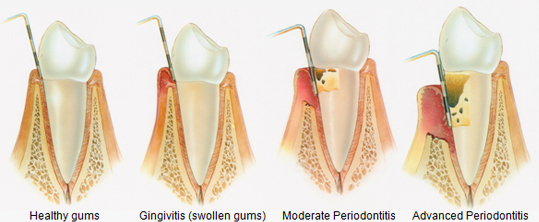Gum Disease
Gum Disease – also known as periodontal disease – is a bacterial infection of the gums and tissues that support your teeth. It is caused most often by the build-up of plaque and tartar when teeth are not routinely brushed and flossed. Other contributors to this disease include medical issues such as diabetes and consuming too much sugary food or drinks.

There are two major stages of periodontal disease: gingivitis and periodontitis.
- Gingivitis is a mild form of gum disease which is described with marked inflammation and redness of the gums. Easy bleeding during brushing or flossing is a common sign of the disease. If properly treated, gingivitis may be reversed; if left untreated, gingivitis turns into periodontitis.
- Periodontitis is a more destructive disease stage in which bacteria penetrate into the deeper areas between the gum and tooth. Periodontitis can lead to early tooth loss and serious health problems.
Research shows that 75% of Americans over the age of 40 have some type of gum disease which is the leading cause of adult tooth loss.
People At Risk
You may be at risk for periodontal disease if you:
- Do not practice good oral hygiene
- Smoke or chew tobacco
- Have heart disease, diabetes, respiratory disease or osteoporosis
- Have a family member diagnosed with periodontal disease
- Are pregnant or thinking of becoming pregnant
Periodontal Treatments
Periodontitis is a chronic disease, like diabetes, which cannot be easily treated in one simple visit. It is a chronic condition which requires the removal of the plaque and tartar from the roots. The most common treatment is scaling and root planing, which removes harmful bacteria that grows within the gums.
Once scaling and root planing is completed, good oral hygiene and frequent dental check ups can help prevent plaque from accumulating again.
